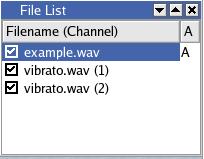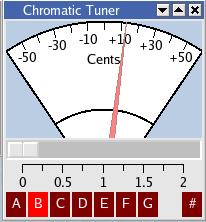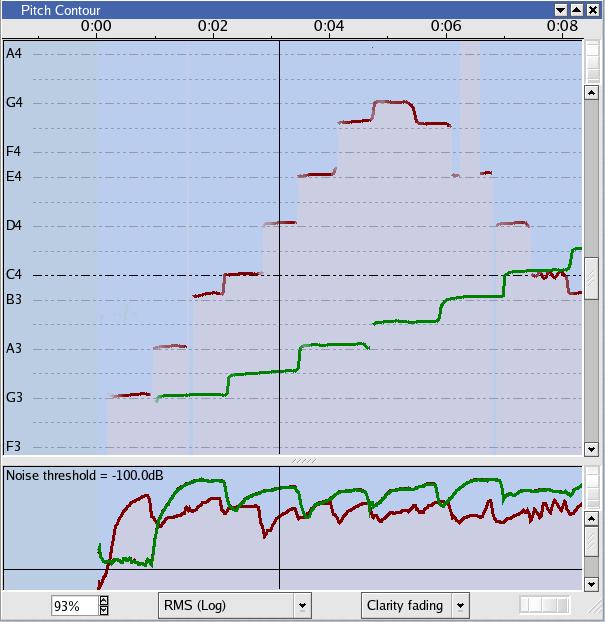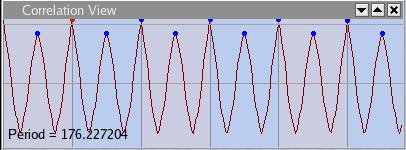 |
TARTINI
the real-time music analysis tool
|
 |
 Department of
Department ofComputer Science |
The main window of Tartini consists of a series of smaller windows. These are called 'views'.
This page discribes the views that appear when the program is run.
Note: The exact look of the view varies between operating system.
Screen-shot of Tarini when first opened

The section letters below refer to the marked yellow dots.
A - Main Tool-bar

Open - Open an existing sound file
Save - Save the active sound
Close - Close the active sound
Record - Start a new sound recording
Auto follow - Toggle on/off vertical centring of the active channel in the pitch view (D)
Background shading - Toggle on/off background colour contrasting of the active channel
Volume - The volume in decibels at the given point in the active file. Shows stereo volume. Sound with the orange colour is the preferred range.
If the volume reaches 0dB it often indicates the clipping is occuring.
B - File View

This shows a list of the currently open channels. Sounds with multiple channels are displayed multiple times, each with the channel number in brackets.
The current active channel is followed by an 'A'.
If the checkbox to the left of channel is ticked then the channel will be visible in the pitch view.
C - Chromatic Tuner

The nearest note on the (equal-temperered) scale is shown at the bottom. The dial indicates the number of cents (1/100th of a semi-tone) away from the note.
Modify the slider to affect the smoothness of the dial, i.e. the number of seconds averaged.
D - Pitch Contour View

This view is split into two windows: Pitch and Dynamics. These are time aligned and are governed by the horizontal scale at the very top of the view (minutes:seconds).
Pitch Window (top)
The vertical scale on the left hand side indicates the musical note and octave. A piano middle C is C4.
The coloured lines in the top window show the how the pitch changes during notes. Each colour represents a channel.
The wheel and scrollbar zoom and scroll the view respectively. You can also zoom with the wheel mouse.
Dynamics Window (bottom)
The bottom window also has coloured lines which represent the choosen type from the drop down box, e.g. Volume using RMS (log).
The horizontal black line in the bottom window represents the noise threshold which can be dragged by the mouse. Sounds below this threshold are considered as noise and not displayed in the Pitch (upper) window.
The vertical black line going through both windows shows the current time. This can be moved by the mouse also.
The spin-box (bottom left) with a percentage indicates the MPM threshold. If the program is choosing the wrong octave for your note then modifying this threshold may help correct this.
Clarity fading means if the note is louder and clearer then the pitch line is darker.
The wheel in the bottom right corner zooms the time axis.
Note: to move the time, use the slider from the bottom toolbar (G) or click and drag the background within graphs.
E - Oscilloscope (Technical)

This shows the waveform of the active channel used in the anaysis of the current frame.
The wheel controls the vertical zoom.
The calculated number of periods is shown. If the Background shading button is toggled on (A), the periods are shown with alternating background colours.
F - Correlation (Technical)

This shows the result of the Normalised Square Difference Function used in choosing the pitch. The dots represent the key maxima found.
The chosen period (in samples) is shown.
G - Sound Action Tool-bar

Beginning - Takes you back to the beginning of the active sound
Rewind - Rewinds at a speed related to the zoom
Play/Stop - Plays or stops the sound file of the active channel from the current position.
Forward - Fast forwards at a speed related to the zoom
End - Takes you to the end of the active sound
Time Slider - This indicates the current time position. Drag the slider with the mouse to move through the sound
[< Prev: How do I get the program working?] [Index] [Next: Creating other views >]